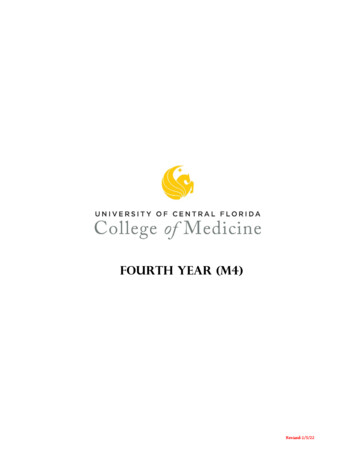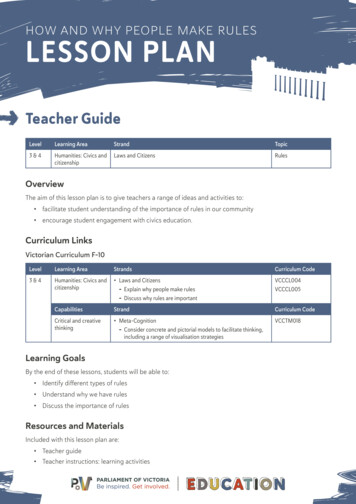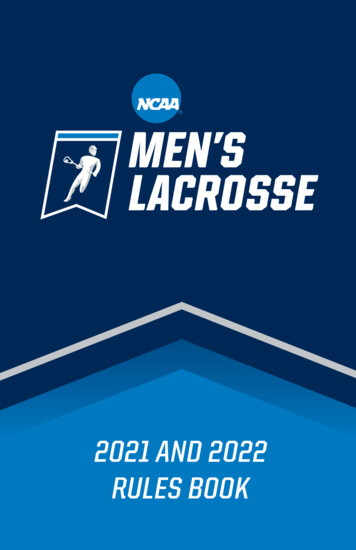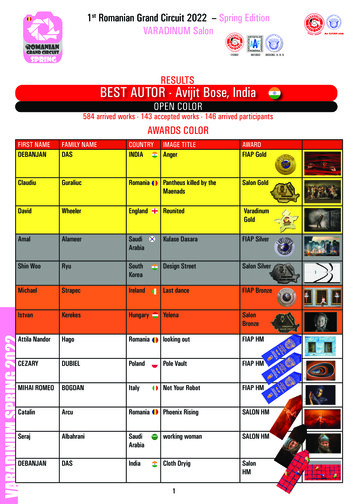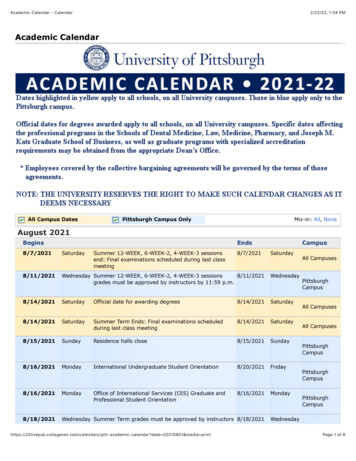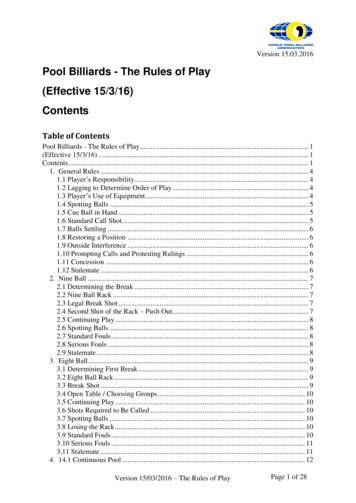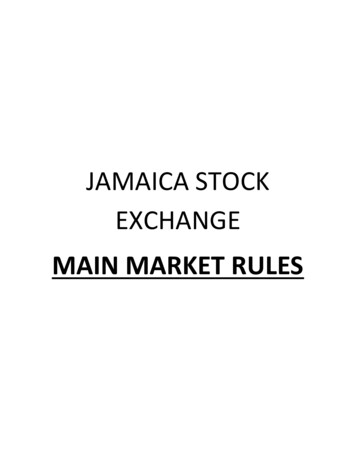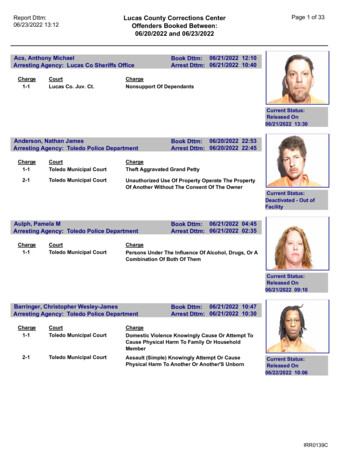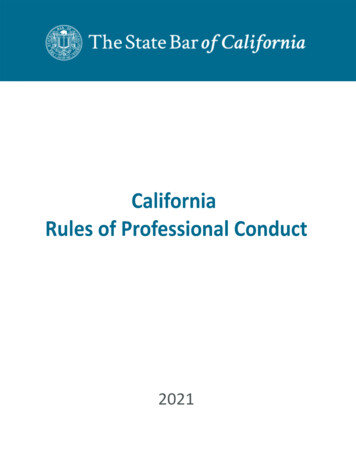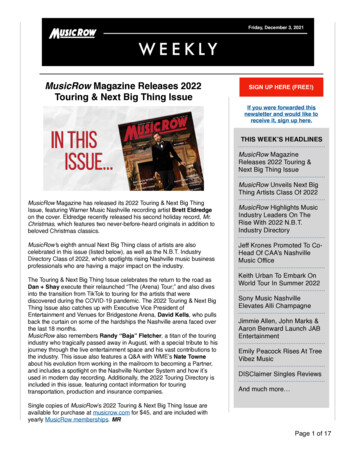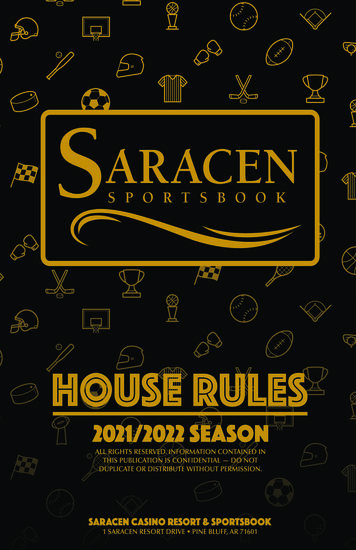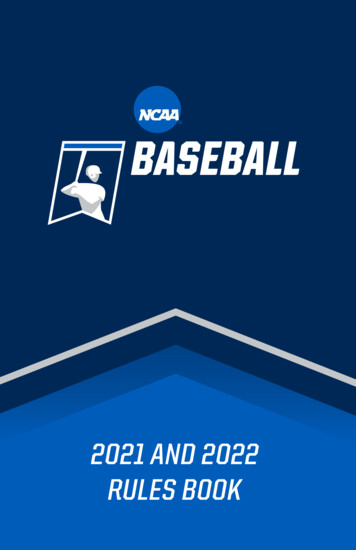
Transcription
baseball2021 AND 2022RULES BOOK
IFiLOSEI’LL RESPOND WITH RESPECT.Don’t undo my hard workwith poor sportsmanship.
2021 AND 2022NCAABASEBALLRULESNATIONAL COLLEGIATE ATHLETIC ASSOCIATION
[ISSN 0736-5209]THE NATIONAL COLLEGIATE ATHLETIC ASSOCIATIONP.O. Box 6222Indianapolis, Indiana 46206-6222317/917-6222www.ncaa.orgoCTOBER 2020Manuscript Prepared By: Randy Bruns, Secretary-Rules Editor, NCAA Baseball Rules Committee.Edited By: Ben Brownlee, Assistant Director of Playing Rules and Officiating.NCAA, NCAA logo and NATIONAL COLLEGIATE ATHLETIC ASSOCIATION are registered marks ofthe Association and use in any manner is prohibited unless prior approval is obtained from theAssociation.COPYRIGHT, 1974, BY THE NATIONAL COLLEGIATE ATHLETIC ASSOCIATIONREPRINTED: 1975, 1976, 1977, 1978, 1979, 1980, 1981, 1982, 1983, 1984, 1985, 1986, 1987,1988, 1989, 1990, 1991, 1992, 1993, 1994, 1995, 1996, 1997, 1998, 1999, 2000, 2001, 2002, 2003,2004, 2005, 2006, 2007, 2008, 2010, 2012, 2014, 2016, 2018, 2020PRINTED IN THE UNITED STATES OF AMERICA
Contents pagePreface 4NCAA Baseball Rules Committee 5Major Rules Changes for 2021 and 2022 6Major Editorial Changes 7Code of Ethics 8NCAA Baseball Umpire Program 9Official NCAA Baseball Rules 10Rule 1—The Game, Playing Field and Equipment 10Diagram of Playing Field 11Diagram of Home Plate 12Diagram of Mound 15Rule 2—Definitions 21Misconduct Chart 25Rule 3—Game Personnel and Their Duties 36Rule 4—Pregame Procedures 41Rule 5—The Game: Its Beginning and Ending 44Rule 6—Ball in Play, Out of Play 57Rule 7—Batting 62Rule 8—Base Running 70Rule 9—Pitching 84Rule 10—Scoring 94Appendix A—Sample Official NCAA Box Score 105Appendix B—Rules for Scoreboards, Audio and Video 106Appendix C—Lightning Policy 108Appendix D—Ejection/Suspension Procedures 109Appendix E—Getting the Call Right 110Appendix F—Pitch/Between Innings Clock Protocol 114Appendix G—Bat Testing Protocols 117Appendix H—Concussions 120Appendix I—Accommodations for Student-Athletes with Disabilities 122Index to Baseball Rules 1233
PrefaceThe NCAA Baseball Rules have been designated as either administrative rules orconduct rules. Typically, administrative rules are those dealing with preparationfor the contest. The conduct rules are those that have to do directly with theplaying of the contest. Some administrative rules (as indicated) may be alteredby the mutual consent of the competing institutions. Others (as indicated) areunalterable. No conduct rule may be changed by mutual consent. All NCAAmember institutions hosting varsity games are required to conduct theirintercollegiate contests according to these rules. NCAA member institutionsplaying games at nonmember institutions may play by the rules of the hostschool. In the NCAA Baseball Rules, the administrative rules that may be alteredby mutual consent of the competing institutions are:Rule 1: Sections 2-b, 3-d, 4, 5, 7, 15, 16.Rule 3: Sections 4, 5.Rule 4: Sections 5, 8.Rule 5: Section 9.The administrative rules that may not be altered are:Rule 1: Sections 3-a, 3-b, 3-c, 6, 8, 9.Rule 3: Sections 1, 2, 3, 6-a, 6-b.Rule 4: Sections 2, 3, 4.Rule 10: Sections 23, 24, 25, 26, 27, 28, 29, 30.All of the other rules are conduct rules and may not be altered.4
NCAA Baseball RulesCommitteeThe chart below lists the members of the committee who voted on and approvedthe rules included in this edition of the book. This information is being includedfor historical purposes.NameInstitutionTerm ExpirationDoug AikenChapman UniversityAug. 31, 2023*Mark BrewLee UniversityAug. 31, 2023John CaseyTufts UniversityAug. 31, 2021Fritz HamburgSaint Joseph's UniversityAug. 31, 2021James JacksonCameron UniversityAug. 31, 2020Brian MurphyCollege of William and MaryAug. 31, 2023Gary OvertonEast Carolina UniversityAug. 31, 2020Chris StandifordGonzaga UniversityAug. 31, 2022**Eligible for reappointment.For a complete and current listing of the NCAA Baseball Rules Committee,please go to: www.ncaa.org/playingrules.The committee invites NCAA head coaches or other interested parties to submitrules-change proposals for the committee to consider at its annual meeting inJuly. Proposals may be submitted online at aying-rules-proposal-form. All rules-change proposals are at thediscretion of the committee.Those seeking interpretations of rules may contact:Randy BrunsNCAA BaseballSecretary-Rules Editorrbruns11@gmail.com319-240-04035
Major Rules Changes for2021 and 2022The figures below refer to rule and section, respectively. Each changed or alteredsegment is identified in the rules by a screened background.Rule Page1-14-jMemorial patches on uniform 192-37Foul tip definition 282-67-bPlay or attempted play definition 325-5-kRe-entry following concussion protocol 475-16Fight rule 546-1-gLive ball 587-2Designated hitter 637-11-hBatter interference - dropped third strike 687-11-nInterference - thrown bat 688-4Force play slide 758-6-a-3Base beyond 799-1-aThe windup 849-1-bThe Set 859-2-ePitcher applies foreign substance 879-3-iCatcher's position in catcher's box 90Appx. B-A-3 Rules for Scoreboards, Video and Audio 106Appx. B-A-4 Rules for Scoreboards, Video and Audio 106Appx. E-2 Coach's challenge process for video review 113Appx. G Bat Testing Procedures 1176
Major Editorial ChangesThe following are editorial changes to the playing rules. Although the editorialchanges are minor, it is the rules committee’s intent to inform umpires, coaches,administrators and players of all changes in the rules book.2021 and 2022 Editorial ChangesRule Page1-12-gEffective date of barrel compression testing forDivisions II and III 171-15-cCatcher's chest protector NOCSAE certification 195-2-eClarified location of the on-deck batter warming up 446-3-aClarified umpire interference with catcher 596-3-bClarified language about play directly followingbatter's interference 597-5-eClarified to include situations with the bases occupied 658-3-eClarified language regarding obstruction 72Appx. FRewritten to address 20-second action limits 1147
Code of EthicsBaseball as a game has been played at the colleges and universities of this countryfor more than 140 years. Only the highest standards of sportsmanship andconduct are expected of players, coaches and others associated with the game.Coaching/Players’ Ethics1. It is the coaches’ duty to be in control of their players at all times in order toprevent any unsportsmanlike act toward opponents, officials or spectators.2. Coaches are expected to comply wholeheartedly with the intent and spirit ofthe rules. The deliberate teaching of players to violate the rules is indefensible.3. Coaches must teach their players to respect the dignity of the game, officials,opponents and the institutions that they represent.4. Coaches must confine their discussion with the game officials to theinterpretations of the rules and not challenge umpire decisions involvingjudgment.5. “Bench jockeying” will not be allowed. Coaches are to prohibit benchjockeying, which would include personal and malicious remarks, cursing andobscene language toward opponents, umpires or spectators.6. Coaches must refrain from any personal action that might arouse players orspectators to unsportsmanlike behavior.7. Coaches must expect from the umpires a courteous and dignified attitudetoward players and themselves.8. Coaches must seek help from school administrators in controlling unrulystudents and spectators.8
NCAA Baseball UmpireProgramFor information regarding the NCAA Baseball Umpire Program, visithttps://ncaabaseball.arbitersports.com, or contact:George DrouchesNCAA National Coordinator of Baseball UmpiresP.O. Box 27641Golden Valley, Minnesota 55427612-432-5351 (mobile)georgedrouches@gmail.com (email)9
RULE 1The Game, Playing Fieldand EquipmentAn Approved Ruling (A.R.) or Note is an official decision of the NCAA BaseballRules Committee [hereafter “rules committee”] regarding a specific rule or partof a rule. It serves to illustrate the spirit and application of the rules. ApprovedRulings or Notes follow the rules they amplify.The GameSECTION 1. Baseball is a game made up of two teams of nine players each. Theteam at bat is known as the offensive team, and its objective is to have its battersbecome base runners and its runners to advance legally, touching all bases. Whenthis is done, a run is scored.The team in the field is known as the defensive team, and its objective is toprevent offensive players from becoming base runners and advancing around thebases. When three offensive players are legally put out, the teams change fromthe offensive to the defensive and from defensive to offensive.The object of each team is to score more runs than its opponents. The winnerof the game shall be the team that scores, in accordance with these rules, thegreater number of runs at the conclusion of a regulation game.In college baseball, the two teams represent their respective institutions andplay the game in conformity with the rules that follow.The Playing FieldInfield, Outfield DimensionsSECTION 2. a. The infield shall be a 90-foot square. Note in the diagram inthis section that the center of second base is one corner of the 90-foot squareand the measurement to first and third bases is to the back edge of each base.All measurements are to be made from the apex or back point of home plate.The outfield shall be the area between two foul lines formed by extending thetwo outer sides of the square.b. The recommended distances for outfield fences are 330 feet from the apex ofhome plate to each foul pole; 375 feet in both right- and left-center field; 400feet in straightaway center field. If the distance to the foul pole is less than 330feet, the fence should be rounded out to the recommended distances in rightand left-center field and straightaway center field, if possible. The foul polesshall be painted fluorescent yellow for new construction and for repainting ofexisting foul poles.Note: This requirement will apply only to college baseball facilities owned by NCAAmember institutions.10
Rule 1 / The Game, Playing Field and Equipment 11c. It is highly recommended that the outfield be enclosed completely by a solidand secure outfield fence. If possible, a permanent fence should be at least 6feet high and preferably 8 feet high.1) If a snow fence must be used, the posts must be placed on the outside ofthe fence, and the top of each post must be below the top of the fence.The top of the snow fence should be bonded with 1-by-4-inch boards onboth sides and flush with the top of the fence. Snow fences are potentiallydangerous, and their use is discouraged.2) The flexible nylon windscreen-type fence is neither solid nor secure andpresents a problem when determining if a ball is caught within the fieldof play. In such a case, caught within the field of play shall mean thatthe defensive player must have possession of the ball (legal catch) whileinside the boundary of the fence. The catch cannot be made legally whilethe player’s foot is stepping on, over or against the fence. All other rulespertaining to a legal catch shall be the same as Rule 2, definition of a catch.Note: A defensive player may touch or lean against the fence with the body or hands andmake a legal catch even though the fence is pushed back, but may not push back or downwith either foot. This rule also pertains to an out-of-bounds fence.
12 Rule 1 / The Game, Playing Field and Equipmentd. All college baseball facilities shall have a regulation bullpen for both teamsconstructed to the exact measurements of the mound on the playing field (see4-3-e).Boxes—Batters’, Catcher’s, Etc.SECTION 3. Batters’ boxes, catcher’s box, coaches’ boxes, next batter’s boxand the 3-foot first base restraining line shall be laid out in accordance with thediagram. All lines must be marked with chalk or nonburning white material andmust be 2 to 3 inches in width. The line is inside the diamond proper at firstand third base. The outside edge of the line should correspond with the outsideedge of the base.a. Before a contest, it is mandatory to line all four sides of the 4-foot-by-6 footbatter’s box as shown in the diagram above. At the time of the pitch, the battershall have both feet inside the batter’s box.b. It is mandatory that the catcher’s box be lined as shown in the diagram above.c. It is mandatory to line or differentiate both coaches’ boxes 20 feet by 5 feetand 15 feet from the foul line as shown in the diagram on page 11. At thetime of the pitch, the base coach may not be closer to the foul line than theinside edge of the coaches’ box and no closer to home plate than the frontedge of the box.
Rule 1 / The Game, Playing Field and Equipment 13PENALTY—Warning on the first offense; an additional violation shall result in thecoach being ejected.d. It is recommended that the first and third base lines be skinned 15 inchesinside of the base line (no more than 36 inches) and 36 inches outside of eachbase line.Surface DrainageSECTION 4. For natural surface drainage, it is recommended that the entireplaying area be graded two-thirds of one percent starting at the edge of thepitcher’s rubber (excluding the mound) to the sideline boundaries of the field.The top of the pitcher’s rubber must be 10 inches higher than the level of homeplate.New FieldsSECTION 5. All new fields should be oriented with consideration to thefollowing factors: protection of players (hitter, catcher, pitcher and others inthat order); comfort of spectators; season of use (March-June); latitude (northto south); east-west geographical location within time zone; prevailing winds;daylight saving time; background; and obstacles or barriers.When constructing a baseball diamond, first designate a point for the rear tipof home plate. Secondly, with the aid of the above guidelines, locate the desireddirection of second base. Using a steel tape or strong cord, measure 127 feet, 33/8inches in this direction. This is the center of second base. With the tape still inthis position, locate the pitcher’s plate 60 feet, 6 inches from home plate towardsecond base. With the tape still fastened to the rear point of home plate, measure90 feet toward first base and scribe a short arc. Also measure 90 feet toward thirdbase and scribe a short arc. Now fasten the tape at the center of second base andmeasure 90 feet toward first and third base, respectively. Scribe a short arc eachtime. First and third bases are located where the respective arcs intersect.a. It is recommended that a warning track be constructed in front of the outfieldfence, backstop and dugout areas. The warning track should be a minimumof 15 feet in width.b. It is recommended that the distance from home plate to the backstop be 45feet and the distance from the base line to the sideline boundary be 60 feetand extended to a point down the line as deep as the skinned portion of theinfield. At this point, the sideline fences are to be extended at an angle to aminimum point of 30 feet outside each foul pole. These distances would beused on each side of the field.c. It is recommended that bullpens be set up outside the playing area andlocated so that relief pitchers will be throwing in the same direction as whenthey throw from the mound on the playing field and that each bullpen havea minimum of two mounds constructed to the exact measurements of themound on the playing field.Each bullpen must be large enough to allow two pitchers to warm up at thesame time and must be equipped with the regulation-size home plates andpitcher’s rubbers.d. All new fields should meet the specifications set forth in 1-2-a and1-2-b.e. The “on-deck” circle, where distance is restricted, should be located aminimum of 30 feet from home plate, in line with the front edge of thedugout. The recommended distance is 37 feet. The on-deck position shall not
14 Rule 1 / The Game, Playing Field and Equipmentbe within a triangle created by an extension of the first base and third basefoul lines. The on-deck position should be in the near vicinity of the dugout(see 5-2-c).Home PlateSECTION 6. Home plate is a five-sided slab of whitened rubber or similarmaterial. One edge is 17 inches long, two are 8½ inches and two are 12 inches.It shall be set in the ground so that the two 12-inch edges coincide with thediamond lines extending to home plate from first base and third base and withthe 17-inch edge facing the pitcher. The top edges of home plate shall be beveled;and the plate shall be fixed in the ground, level with the ground surface.Note: It is permissible for home plate to be a white painted area with these exactdimensions on a field where the entire home plate area is covered by artificial turf.First, Second and Third BasesSECTION 7. First, second and third bases shall be white canvas bags, or suitablerubberized material, securely fastened to the ground. Each bag shall be 15 inchessquare, filled with soft material to a thickness of 3 to 5 inches.a. A release-type base may be used for NCAA competition.b. The double first base may be used only during regular-season competition.Pitcher’s RubberSECTION 8. The pitcher’s rubber is a rectangular whitened rubber slab, 24inches by 6 inches, set in the ground with the nearer edge at a distance of 60 feet6 inches from the back point of home plate.Pitcher’s MoundSECTION 9. a. The top of the pitcher’s rubber must be 10 inches above thetop surface of home plate. The 10-inch height can be measured easily by the useof a line level. There should be a gradual slope of 1 inch per foot from a point 6inches in front of the pitcher’s rubber to a point 6 feet toward home plate. Fromthis point, the mound should slope and blend into the grade of the rest of theplaying surface.b. The top of the pitcher’s mound should be level with the top of the pitcher’srubber, extending from the point 6 inches in front of the pitcher’s rubber to22 inches behind the pitcher’s rubber and 18 inches from each end of thepitcher’s rubber. This gives a level area 5 feet wide and 34 inches deep thatincludes the 6-inch width of the pitcher’s rubber.c. Maintenance of the pitching mound, before and during games, should bethe responsibility of the home management. Unburnt brick clay, plasticblue or gray clay mixed with some of the existing soil is recommended forreconditioning worn out spots. It is recommended that the home managementprovide foul weather covers for the home-plate and mound areas.d. Portable pitcher’s mounds are legal. Both teams must agree on their use beforethe visitors arrive at the game site.
Rule 1 / The Game, Playing Field and Equipment 15EquipmentSECTION 10. The rules committee is responsible for formulating the officialplaying rules for the sport.Only equipment that meets specifications published in the NCAA BaseballRules may be used in intercollegiate competition. The rules committee isresponsible for interpretations of NCAA rules and for compliance with thoserules.The rules committee suggests that manufacturers planning innovative changesin baseball equipment submit the equipment to the rules committee for reviewbefore production.The BallSECTION 11. The ball is a sphere weighing not less than 5 nor more than5¼ ounces avoirdupois and measuring not less than 9 inches nor more than9½ inches in circumference. It shall be formed by yarn wound around a smallcore of rubber, cork or combination of both and covered by two pieces of whitehorsehide or cowhide tightly stitched together. The coefficient of restitution(COR) of a baseball cannot exceed .555.a. The home team shall present one dozen game baseballs to the umpires to berubbed up to remove the gloss before the game starts. Enough balls should berubbed up so that a glossy ball is not used in the game. Moistened river siltmakes an excellent material to remove the gloss from baseballs.b. Before the game, the umpire-in-chief shall determine whether game ballsmeet those specifications. During the contest, any umpire may judge thefitness of the ball for play.c. No player shall intentionally damage or discolor the ball.PENALTY for c.—The umpire shall demand the ball, warn the player and if thepractice continues, remove the player from the game.
16 Rule 1 / The Game, Playing Field and EquipmentThe BatSECTION 12. a. Wood bat.1) The bat must be a smooth, rounded stick not more than 2¾ inches indiameter at its thickest part nor more than 42 inches in length.2) There must be a direct line from the center of the knob to the center ofthe large end.3) Any material to improve the grip may be used for a distance not to exceed18 inches from the end of the handle.4) An indentation in the end of the bat up to 1 inch in depth is permitted(cupped bats).5) All bats other than one-piece solid wood must be certified in accordancewith the NCAA certification program.b. Nonwood bat.1) The entire hitting area of the bat must be round with a constant radius atany point and the finish of the hitting area must be smooth.2) There must be a direct line from the center of the knob to the center ofthe large end.3) The maximum length is 36 inches and the maximum diameter is 2 5/8inches.4) The knob and end plug (if applicable) must be firmly attached.5) A bat may not weigh, numerically, more than three units less than thelength of the bat (e.g., a 34-inch-long bat cannot weigh less than 31ounces).6) A nonwood bat must have an approved, coded certification mark on thebarrel of the bat signifying the bat is legal for NCAA competition.7) Beginning in the 2020 NCAA Championship segment, the bat barrelcolor must be of a predominantly contrasting color to the color of thebaseball between the 18-inch mark to the end cap.PENALTY for a. and b.—A bat that has been flattened or altered to improveperformance is an illegal bat. If such an illegal bat is detected before thefirst pitch, the batter shall be called out and the bat shall be removedfrom the game. If an illegal bat is detected after the first pitch, legalor illegal, the batter shall be declared out, and base runners shall notadvance as a result of a batted ball. The bat shall be removed from thecontest.c. There shall be no external attachment(s) to any part of the bat. A leather,rubber or taped grip is permitted to be placed on the bat handle.d. There shall be no data collection or transmission devices externally attachedor embedded within any part of the baseball bat.e. It is mandatory that all bats have an identification mark 18 inches from theend of the handle. No foreign substance that will in any way discolor the ballmay be added to the surface of the bat beyond 18 inches from the end of thehandle.f. For game and practice use, all nonwood bats must have a leather, rubber ortaped grip securely attached to the bat handle.PENALTY for e. and f.—If the bat is not marked 18 inches from the knob, or haspine tar or a foreign substance beyond the 18-inch mark, the bat mustbe removed from the game and the player warned. If the practicecontinues, the player is to be ejected from the game. If a bat’s handle
Rule 1 / The Game, Playing Field and Equipment 17should become loose and the bat must be removed from the game, thesame practice is to be followed. Neither of these infractions is cause forcalling the batter out.g. Bat testing. The NCAA Baseball Rules require all nonwood bats usedduring competition be reviewed by baseball bat testing conducted prior toeach regular season series or single date of competition. A bat must satisfyall sections of the bat testing process to be compliant for competition.Bats failing any section of the testing protocol shall be surrendered togame management and be retained for the duration of the game, series ortournament for being unacceptable for play. The purpose of this testing is toensure that legal equipment is used in competition. Rule 4.4.c requires thatcoaches confirm that their team is playing with legal equipment. All bats usedduring competition must appear on the NCAA Approved Bat List, pass thebarrel ring test and barrel compression testing. Bat testing is required for allNCAA competition during the 2021 season, with one exception. Bat barrelcompression testing will be required for NCAA Division II and III membersbeginning with the 2022 NCAA championship segment.Gloves or MittsSECTION 13. a. The catcher may wear a glove or mitt of any dimension.b. The first baseman’s glove or mitt must not be more than 13 inches long or 8inches wide. The webbing shall not be constructed so as to form a net typeof trap. The length measurement of any glove/mitt shall be from the bottomedge or heel straight up across the palm. The width measurement for thefirst baseman’s mitt shall be from the center of the base section between thethumb and the first finger to the outside edge of the little finger. The crotcharea for the first baseman’s mitt shall not exceed 5 inches in length, 4½ inchesin width at the top and 3½ inches at the base.c. Every player except the catcher and first baseman is restricted to the use of afielder’s glove not more than 13 inches long nor more than 8 inches wide. Forthe fielder’s glove, the measurement shall be from the base of the inside seamof the first finger to the outside edge of the little finger. These measurementsshall not exceed 5¾ inches in width at the top and 3½ inches at the base.PENALTIES for a., b., and c.—(1) A violator shall be given reasonable time to correct the situation. If itis not done, the violator shall be ejected from the game.(2) If a play is made with illegal equipment, the offensive team has thechoice of taking the play or having the play voided with the pitchbeing made again (see 8-6-b).d. The pitcher’s glove may not be white or gray, exclusive of piping nor, in thejudgment of the umpire, be distracting in any way.PENALTY for d.— A violator shall be given reasonable time to correct the situation.If it is not done, the violator shall be ejected from the game.UniformsSECTION 14. The uniforms of all participating players and coaches of the teamshall be of the same color and style.It is required that each team have two sets of uniform jerseys of contrastingcolors. It is the responsibility of the visiting team to wear a contrasting uniformcolor to the jersey worn by the home team. It is recommended that both teamswear the full pregame or regular-game uniforms when entering the playing field.
18 Rule 1 / The Game, Playing Field and Equipmenta. All uniforms must include numbers on the back of the shirt. These numbersshall be at least 6 inches in height.b. Except for the standard shoe plate
the rules included in this edition of the book This information is being included for historical purposes Name Institution Term Expiration Doug Aiken Chapman University Aug. 31, 2023* Mark Brew Lee University Aug. 31, 2023 John Casey Tufts University Aug. 31, 2021 Fritz Hamburg Saint Joseph's University Aug. 31, 2021
